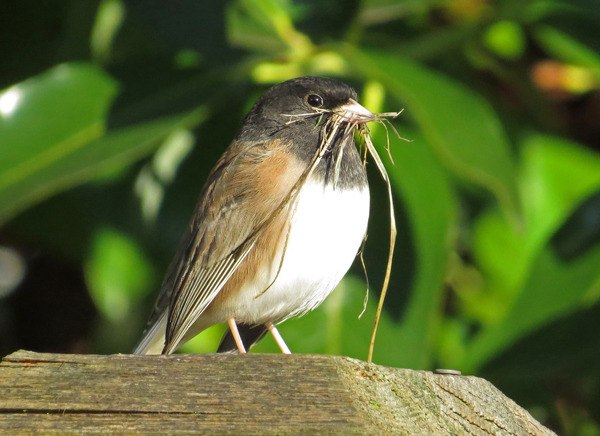Aren’t these 60-degree February days amazing? As our weather warms, some of our feathered friends are beginning their spring breeding cycle.
The resident Anna’s hummingbirds are some of the earliest of our nesting birds. I had several reports of these birds engaged in courtship behavior during our bright, snowy days last month. Resident juncos, chickadees, nuthatches and towhees will be following soon.
Craig Johnson photographed this male dark-eyed junco on Jan. 2. The male of this species gathers materials and the female assembles the nest.
Recently my husband and I met up with some friends from South Carolina for a birding trip and I heard an amazing story about one bird that nests in their garden on Spring Island in the southeastern part of the state.
The events began in late March of 2007, when Nona was sitting quietly on her deck reading. A tufted titmouse, a common greyish bird of the eastern United States, which is about the size of a chickadee, flew to the deck railing and began to eye her. The bird flitted to the back of her rocking chair and paused there for a moment before landing right on top of her head. It surprised her, but she managed to remain calm.
The bird began pecking at Nona’s long blondish-gray hair. A bird lover through and through, Nona sat still and let the bird collect bits of hair right from her head. For the next two days, as she quietly read in the morning, the titmouse returned and gathered more strands of her hair.
I kid you not; Nona showed me a selfie video she took with the titmouse pulling at strands of her hair.
Each spring for the following eight years (with only one year’s interruption) a titmouse, she can’t be sure it’s the same one, returns to gather nesting materials from Nona’s head. The bird won’t come near if her husband is outside on the deck, but he’s managed to take photos from inside the kitchen.
Even during the year when Nona was recovering from cancer and wore a wig, the titmouse returned and pecked at the wig in the same way it had gathered her real hair. From research on this species, Nona learned that they often target living mammals to gather fur and hair.
Of course we don’t have this species in the West, our weather would prohibit sitting outside in early spring, and I would not expect anyone to be as calm and patient as Nona. Yet, we can offer nesting materials to our Whidbey birds.
Those early nesting Anna’s hummingbirds look for dried grass, which they bind together with spider webs. The elasticity of the spider webs allows the nest to expand as the babies grow.
Since finding dry grass or the soft fluff of seed heads is difficult in our wet weather, you might want to hang materials outside for the birds to discover. Brushings from pets or strands from your hairbrush are possibilities.
You can cram all these bits and pieces into a mesh bag, or an empty suet feeder. Or stop by a wild bird supply store and purchase nesting materials.
I hang my offerings near where the birds frequent my seed feeders. I position them in a dry place well under the eaves but also where I can watch the birds arrive and claim their selections.
If this weather continues, we’ll be able to enjoy more and more bird breeding activity this month. Even if winter returns, singing, courtship, nest building and nestlings will follow soon.
Frances Wood can be reached at wood@whidbey.com. Craig Johnson is at Craigjohnson@whidbey.com.



